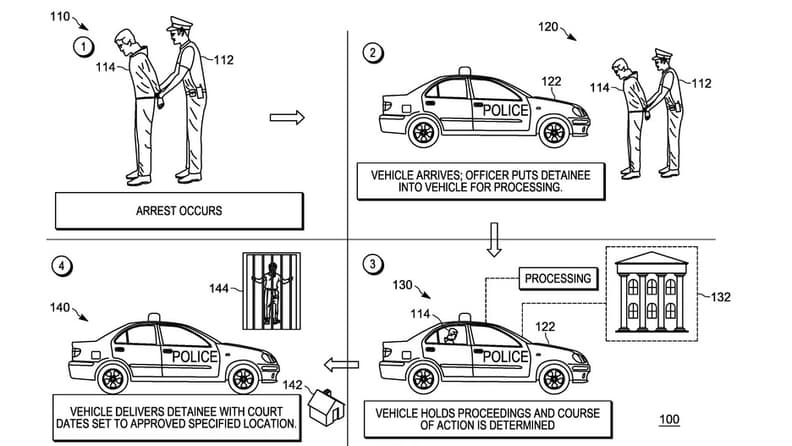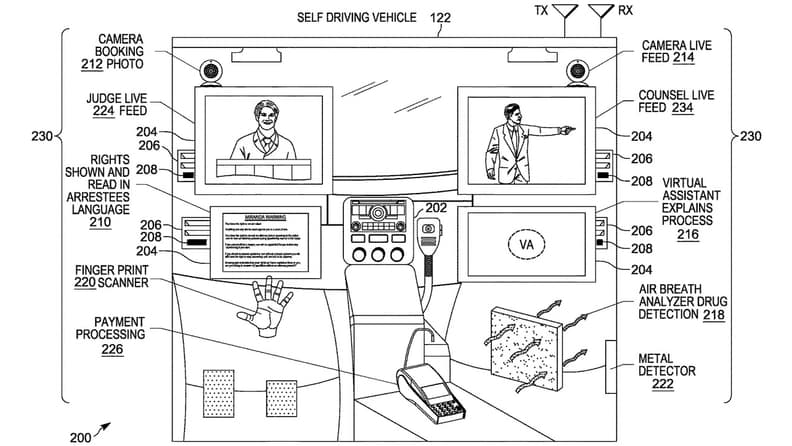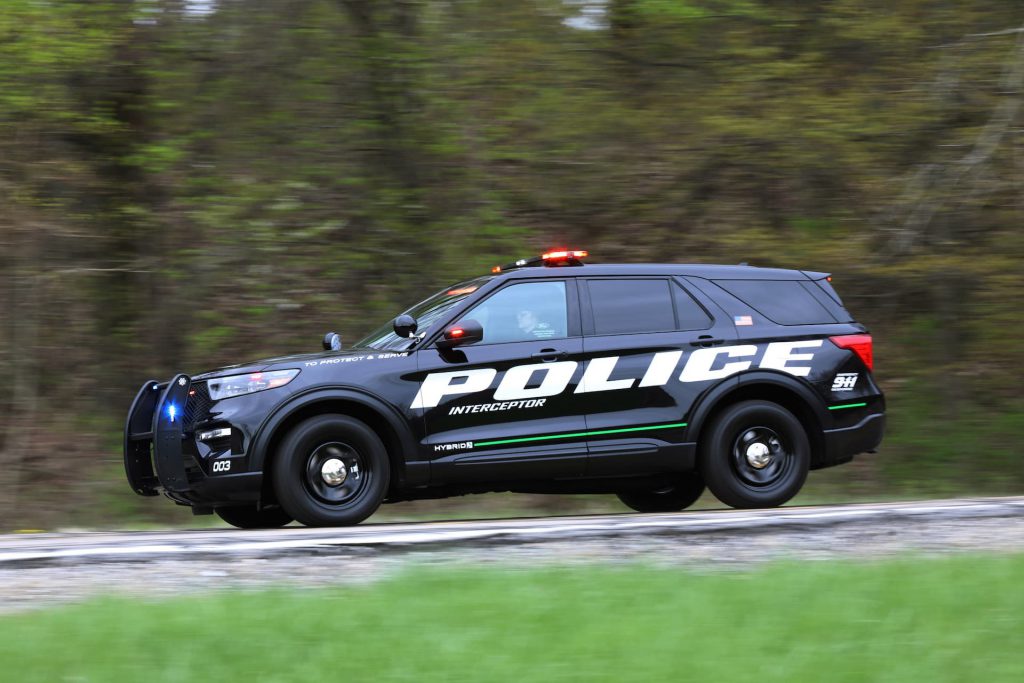From the addition of vinyl decals to the inclusion of MDTs, a lot has changed in the patrol vehicle since it hit the Ohio streets in 1899.
Even though most future patrol vehicle models and features are treated like state secrets by Chevrolet, Dodge (FCA), and Ford etc, what can we say about the next generation of law enforcement vehicles?
Self-Driving Cars that Arrest?

(Image source: autoweek.com)
The idea is convenience; to develop a car so smart that not only could it drive itself, but could also arrest and process detainees.
Motorola has submitted a patent for self-driving police vehicles that handle the entire processing of the detainee, including a live video feed with a judge, as well as their legal representative, before transportation to the appropriate facility.

Motorola says arrests for minor crimes can be complex and time-consuming and so this new technology aims to speed up the process and free up time for police officers. The patent reads: ‘By performing law enforcement processes and proceedings within a vehicular environment, an officer is able to remain in the field, thereby advantageously preserving law enforcement resources.’
Electric Vehicles and IoT Technology for Police

(Image source: www.motorauthority.com)
Electric vehicles (EVs) and Internet of Things (IoT) technology offer numerous benefits to law enforcement agencies. EVs reduce fuel costs, are environmentally friendly, and emit no exhaust, making them cost-effective and sustainable options for police fleets. Hybrid EV are highly suitable for patrol vehicles: Policing requires a lot of stop-and-go driving where it is best to keep the lithium-ion batteries charged. This stored charge is what powers the electrics during extended stops rather than an alternator spun by an idling gasoline-powered engine.
IoT technology enhances the capabilities of patrol vehicles by enabling real-time data collection, analysis, and remote vehicle monitoring. With IoT, police vehicles can be equipped with GPS tracking, enabling precise location and route tracking for better response times. Sensors can monitor vehicle health and alert for maintenance needs, ensuring fleet reliability. Moreover, IoT-enabled dashcams and body cameras enhance evidence collection and officer safety. The fusion of EVs and IoT technology empowers police departments with efficient, eco-friendly, and data-driven resources to protect their communities.
Ford recently introduced the 2020 Ford Police Interceptor Utility with hybrid powertrain. Based on the 2020 Explorer SUV, it’s the first hybrid big enough to accommodate the power needed in contemporary police operations.
The Future is Autonomous
Looking into the future, Ford has filed a patent on an autonomous police car that describes a vehicle being able to detect infractions performed by another vehicle; either on its own or in conjunction with surveillance cameras or road-side sensors.
Imagine a police car that issues tickets without needing to pull you over and, at the same time, this car can identify drivers using Artificial Intelligence technology.
According to the patent, the AI-powered police car could wirelessly connect to the infringing car, communicate with the passenger, verify identity, and issue a citation.
Considering how quickly autonomous vehicles are being developed, it appears plausible that AI-driven policing may be an aspect of our future.
Kustom Signals Technology for Today’s Patrol Vehicles
At this point, the idea of autonomous patrol cars still seems somewhat dystopian and controversial. There are, however, other types of law enforcement AI, like Argus BWC, that are now being widely adopted to make the role of police officers easier.
The Eagle 3 is the first RADAR to provide a method to independently verify the Doppler patrol speed without an electrical connection to the patrol vehicle. Its patented Wireless Speed Sensing has an integrated antenna that utilizes satellite signals as an independent speed source to verify the patrol vehicle’s Doppler ground speed. This feature eliminates common RADAR anomalies like shadowing, batching, and combining. It also enables the popular feature for automatic mode switching from stationary to moving operations and vice versa. Other important features include:
- Scan Mode with dual antenna operations (patented)
- eFork™ electronic tuning fork in the remote control
- Advanced Fork Test with optional mandatory fork test (patented)
- Certification Management with optional lock-out when certification expires
- DuraTrak™ tracking bars improve target tracking confidence (patented)
- QuikTrak™ one button target tracking with lock defeats RADAR detectors (patented)
- Fan noise and interference filtering eliminate unwanted RADAR anomalies
- Faster processing provides a greater targeting range and improved target acquisition
Argus ICV’s HD Dual View Camera allows for the capture of both a wide angle and telephoto 1080p views simultaneously. The telephoto lens can be physically pivoted to capture important moments and provide an enhanced live view for the user. The HD Interior Camera can be mounted wherever is most convenient thanks to its wide view. The infrared can be used to make sure that nothing is missed.
The Argus ICV’s Android-powered tablet allows for the convenient review and classification of footage. Easily view multiple feeds or focus in on a single camera to view the live feed or review footage to see what exactly was caught on camera. Additional advantages of Argus ICV are its ability to integrate with Argus Body Worn Camera and Argus Data Vault.
Your agency can securely manage data evidence files with a digital evidence management solution, such as Argus Data Vault. Argus Data Vault combines the power of an easy-to-use back office system with smart fleet management tools to help your agency keep a vigilant eye on all of its officers.
Kustom Signals remains your leader for in-car technology solutions and innovative speed enforcement technology.
Contact us to learn more about how we can support your law enforcement efforts. Our team is dedicated to producing technologies that make your job safer and easier.

